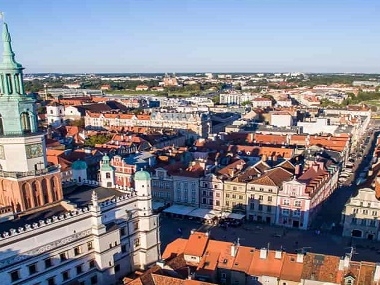Focus On: Poznan - about the city
Edited on
23 December 2021The second 'Focus On' of the four cities in the USE-IT project is Poznan in Poland. Here are some interesting facts about the city, alongside a quick background.

Interesting Facts About Poznan
Country – Poland
Population – 532,048
Area – 261.9 km2
Architecture – Stare Miasto (Old Town), including the Town Hall, much of which was rebuilt identically following the Battle of Poznan in 1945.
Transport – Poznan-Lawica Henryk Wieniawski Airport is one of the largest in Eastern Europe and the extensive Tram Network has 21 lines dating back to 1880.
Twinned Cities – Twinned with 16 towns/cities including: Brno (Czech Republic), Gyor (Hungary), Hanover (Germany), Kharkiv (Ukraine) and Shenzhen (China).
About Poznan
The City of Poznan is located in Western Poland in the Wielkopolska region. It is an important centre for trade, sport, education and leisure activities. It covers an area of 261.9 km2, with the urban areas of the city making up around 46.2% of the total area. Interestingly, nearly one-third (31.3%) of the Poznan city area is used for agriculture.
Dating back to 8th century, Poznan has a rich history. The city was the centre of the early Polish State. Centred around the Cathedral, trade and industry began to develop and Poznan expanded. This expansion happened outside the original City Walls, that form the area of today’s Stare Miasto ‘Old Town’. Much of the city was rebuilt following the Battle of Poznan in 1945. Impressively, parts of the city were reconstructed almost identically, as the buildings stood before the war.
Today, Poznan has a registered population of 532,048 people (as of 2020) with 46.7% of people being male and 53.3% female. The actual population is estimated to be greater than official figures show, with 50,000 migrants in the city, largely from the Ukraine.
The economy of Poznan is strong and growing. In 2018, GDP per capita stood at 106,264 PLN (around €24,000), which is an increase from around €16,000 in 2010. This GDP per capita figure is roughly double the Polish average. This strong economic performance is also reflected in the 350,000 people currently in employment – being second only to Warsaw. In terms of sectors, the vast majority of jobs are in the service sector (80.2%), with 19.2% in industry and construction, and 0.6% in agriculture.
Like any European or UK city, Poznan has disparities between neighbourhoods when it comes to economic growth and inequality. 5 of Poznan’s 42 Estates have levels of welfare benefit claimants that are above 10% of the resident population, namely Fabianowo–Kotowo (11.9%), Główna (11.8%), Górczyn (13.6%), Grunwald Północ (11%), and Święty Łazarz (18.7%).
Despite the high levels of economic growth, industry and construction; Poznan retains a relatively good air quality and is a liveable city. It is ranked 17th amongst Polish cities at risk of high pollution levels, though the city has a range of open spaces and woodland areas, including 120 open green spaces (over 1,000 hectares) and urban forests (of more than 3,800 hectares).
The next part of our Focus On, will look at how Poznan is building on it's strengths and working towards the USE-IT model with various projects in the city.
 Submitted by James Carless on
Submitted by James Carless on
